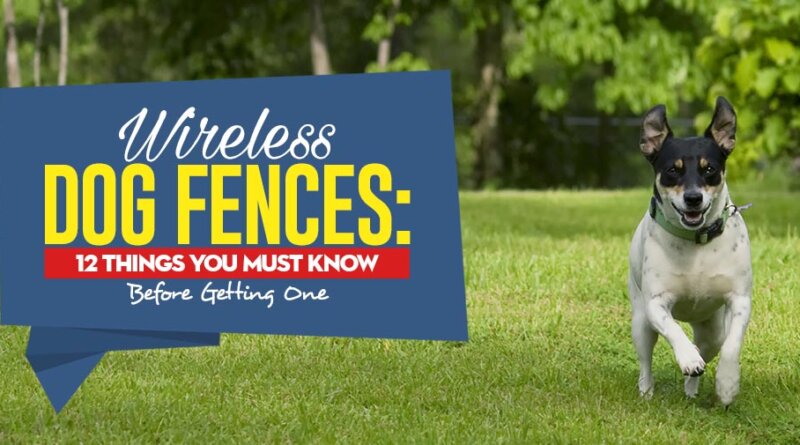12 Pros and Cons You Must Know [Infographic]
All inner-city dog owners secretly envy those in the suburbs or the country.
They get the benefit of having a yard, and an open grass space where your dog can run, jump, play, and have fun is a great benefit that not all pet owners get to enjoy.
But having a yard is more challenging than one may think.
You’ll need to train your pup to stay in that yard. Otherwise, he’ll be exposed to various dangers.
A wireless dog fence can make boundary training easier for you and your pet.
Talking to pet owners and browsing dog forums, it’s clear how there’s a common problem among those living in houses with yards.
“He’s always running away!
How do I guarantee my dog stays inside the yard while I’m away?!”
This is especially true for those with escape artist breeds who will do whatever they can to leave your backyard and seek their freedom.
Proper containment is crucial for the pet’s safety. Some options include physical fences, dog stakes, and a few others.
A wireless dog fence may be one of the most popular options today. It offers several benefits, but it also has disadvantages.
So here’s what you should know before buying one:
Like this infographic? Spread the word! Share it on your site:
<p><strong>Please include attribution to TopDogTips.com with this graphic.</strong></p><p><a href="https://topdogtips.com/wireless-dog-fence/"><img src="https://topdogtips.com/img/Wireless-Dog-Fence.jpg" alt="12 Pros and Cons of Wireless Dog Fences" border="0" /></a></p>
Wireless Dog Fence
12 things you must know before buying it
Keeping Dogs Contained
Most dog breeds may be generally less athletic than most cats.
Still, many pet owners – including people who have owned their dogs for years – are often surprised to discover the actual limit of their pet’s athletic prowess.
Many dog breeds can jump and climb fences, walls, and trees that seem impossible to us.
If your first thought is that these are just the extremes and that not all dogs can do that, then you’d be right.
However, you need to consider whether or not you’re willing to take that chance with that your pup.
Are you sure that the environment surrounding your house is safe for your dog?
Are you confident that your dog won’t get lost?
These questions will make most pet owners uneasy, and a wireless dog fence can ease these worries and give you peace of mind.
The simple fact is that basic physical wooden/stone/wired fences are often a must-have for a dog owner’s yard, but more is needed.
Unless you want to turn your house and yard into a fortress that can only be accessed through the door or a helicopter pad, you should always keep an eye on your dog.
A lot of pet owners set up webcams in their yard while they are away to find out what their dog is doing while they are away.
And, while most of them are often surprised by what they see, the major problem is that once the deed is done and your dog is out, there’s usually not much you can do.
So, what can you do to stop your furry escape artist from getting into trouble?
Aside from the must-have GPS activity monitor, you can attach to its collar in case it escapes, the next logical step is to consider a wireless fence.
OUR PICKS: Top 10 Best Invisible Dog Fences for Dogs’ Containment
What is a Wireless Dog Fence?
Well, it isn’t just the opposite of a wired fence; that’s a given.
In fact, a wireless fence isn’t really a fence; it just acts as one.
A wireless fence is a radio device that you plug into an outlet in your house.
From there, it emits a simple radio signal in a radius around itself and around the house.
The range of that radius depends on the device and how you set it up.
Generally, it can vary from 10 feet to 150 feet.
At maximum, a wireless fence can cover multiple acres!
This radio signal can be detected by a device that’s put into your dog’s collar or your dog’s new collar when you purchase a wireless dog fence system.
And whenever your dog gets close to the circular perimeter formed by the radio emissions, the collar gives a sound warning that aims to stop Fido.
If your dog ignores the sound (which isn’t unlikely) after several feet, the collar emits stimulation called a “static correction.”
It’s nothing painful or hurtful, just enough stimulation to surprise your dog and stop him in his tracks.
A wireless dog fence is quite similar in its purpose to a standard training shock collar.
By themselves, the beeping and static correction aren’t going to be able to protect your dog.
If a wireless fence is to work for your dog, he needs to be trained to work with it.
This is known as boundary training.
Most wireless dog fence systems contain detailed instructions on training your pet to understand his physical boundaries.
What this training includes is similar to standard shock collar training.
You’ll walk with the dog and train him that the sound and the static warnings are to be acknowledged and obeyed.
Following the sound’s and the shock’s commands is rewarded, and ignoring them is terrible.
If dog training isn’t your forte, then it may be a good idea to talk to a specialist, but if you are fairly competent with training your dog, you should be fine.
A well-trained dog will obey the warnings of its collars without hesitation.
They are trained for all temptations that await him or her beyond the invisible barrier of the wireless fence’s radio transmitter.
Ideally, a wireless fence works best with an actual fence, be it a wooden, stone, or wired one.
This is only ideal, however, if the yard is huge.
The wireless fence needs to be set up with a radius inside the physical fence, and it has its own ranges: the sound warning and shock warning ranges.
If the yard isn’t big enough, you risk making your dog’s living space too small.
MORE INFORMATION: Pros & Cons of Wireless Dog Containment Systems
Cons of An Wireless Dog Fences
Wireless dog fence systems are not perfect.
While they are ideal for some homes, they will only work for some pet owners.
Here are some of the limitations and problems that may determine whether or not a wireless dog fence is the right way to contain your Fido:
Only offers a circular perimeter
A wireless fence can only be set up in a circle.
Since you can’t set up radio waves to be emitted in a square-shaped formation, the yard space will always be circular.
If that doesn’t work with the shape of your property, yard, or physical fence, then a wireless fence is not for you.
Instead, look into an underground dog fence.
Not ideal for uneven terrain
Wireless fences work best only on fairly even terrains.
The radio emission may not be ideal if your property or yard has too many slopes and bumps.
And, when that’s the case, you might as well use a wooden fence with actual holes in it.
Since near-perfectly flat yards and properties are not always available, a wireless dog fence may not be the best choice here, either.
If you need help deciding if the terrain of your yard is suitable for a wireless fence, consult with the manufacturer.
Ask them for a detailed and fair opinion on your yard and provide them with all the information they can use to give you the best possible advice.
Sure, it’s in every manufacturer’s interest to make a sale, but they also don’t want unsatisfied clients.
Large items may interfere
Big obstacles such as trees, garages, or other large objects also interfere with the radio transition.
This usually doesn’t mean that your yard should be utterly devoid of items.
Still, you should carefully make sure that the radio emission successfully reaches your property’s perimeter without any hiccups.
Is your yard big enough?
As we mentioned above, wireless fences for dogs work wonders with physical ones. However, they only work when the yard is big enough. Otherwise, the wireless fence will limit the dog’s playground/living space too much and make it unusable.
They don’t work in every climate
As with all radio waves, the radio emissions of the wireless fence are influenced by atmospheric conditions.
Just like your Wi-Fi or radio signals aren’t always 100%, this will be the case with your wireless fence.
Make sure that your climate is suitable for a wireless fence.
They allow other animals to enter your yard
Wireless fences work only for your dog, or in other words, for whoever wears the collar of the wireless fence.
This, in other words, means that while your dog can’t leave your property, other animals, including stray dogs or wildlife, can and will.
This is especially dangerous when you live in an area with a lot of wildlife – coyotes, for example, are known to attack small domesticated dogs quite often.
Make sure that the terrain, weather, and fauna around your home are also suitable for a wireless fence.
You must do the work
Last but not least, wireless dog fences require you to train your dog.
An untrained dog will only be mildly inconvenienced by a wireless fence and will proceed to chase down squirrels, birds, and cars carefree throughout your neighborhood.
If you need more confidence in your abilities to properly train your dog to obey the wireless fence, get a professional to help.
You could also look for another way to contain your dog.
Benefits of a Wireless Dog Fence
Now, that seems like a bunch of negatives.
Don’t worry.
We’ll spell out the benefits; for some, they will outweigh the disadvantages.
Yes, wireless dog fences are not suitable for every home and dog.
Yet, when they work, they work beautifully.
The key to the whole situation is to carefully analyze all the pros and cons of your situation, property, and pet.
You’ll then be able to determine whether or not to get a wireless fence or choose another method for fencing your yard.
And to further ease this analysis, here are some of the undisputed positives of wireless fences:
They’re easy to setup and use
No other method of fencing your property is as easy to set up as a wireless fence.
As long as the terrain is suitable, all you need to do is plug in the radio emitter in your house, set up its range, and that’s it.
Yes, you need to train your dog to respond to the collar.
But training your pet is something that most responsible dog owners do anyway, so it shouldn’t be much of a bother.
Installation is free
The whole installation is not only quick but is also exceptionally cheap – or free, excluding the price of the device itself.
We’re all on a budget, right?
A wireless dog fence will be much more affordable than any physical fence.
You don’t need to dig holes for a wooden or underground fence.
You don’t need to raise it up to 12 or 15 feet or need to maintain it.
It’s just there, like an invisible, magical field that protects your dog from its own instincts.
A wireless dog fence is invisible
This is definitely not a small benefit – with a lot of dogs, especially skillful expert artists like terriers or pit bulls, even a 12-foot wired fence can be inefficient.
To stop such an athlete with a physical fence sometimes means turning your yard into an impenetrable fortress and, as a result – cutting your entire view of the outside world.
Not with a wireless fence – it will do its job perfectly while you stare blissfully at whatever lies beyond your yard.
A wireless dog fence is portable
Many people often need to remember that a wireless fence is also portable!
Think about it for a second – next summer, your partner decides that you should go camping.
Naturally, you take the dog with you.
How do you make sure that he doesn’t get into trouble while you are camping, however?
With a wireless fence, it’s exceptionally easy – you take the entire fence with you!
Imagine bringing a 3-acre wooden fence to a camping trip – now that’d be an adventure.
With a wireless fence, it’s not even a concern.
They can be paired with a physical fence
A physical and wireless fence combo is an excellent option if your yard or property is big enough.
It is also a surefire guarantee that your dog will always be safe inside your yard, no matter what.
READ NEXT: Lost Dog – How To Cope with Every Dog Owner’s Worst Nightmare
Pin and share with other dog owners:
Related


![12 Pros and Cons of Wireless Dog Fence [Infographic] 12 Pros and Cons of Wireless Dog Fence [Infographic]](https://topdogtips.com/wp-content/uploads/2017/10/Wireless-Dog-Fence-9.jpg)






